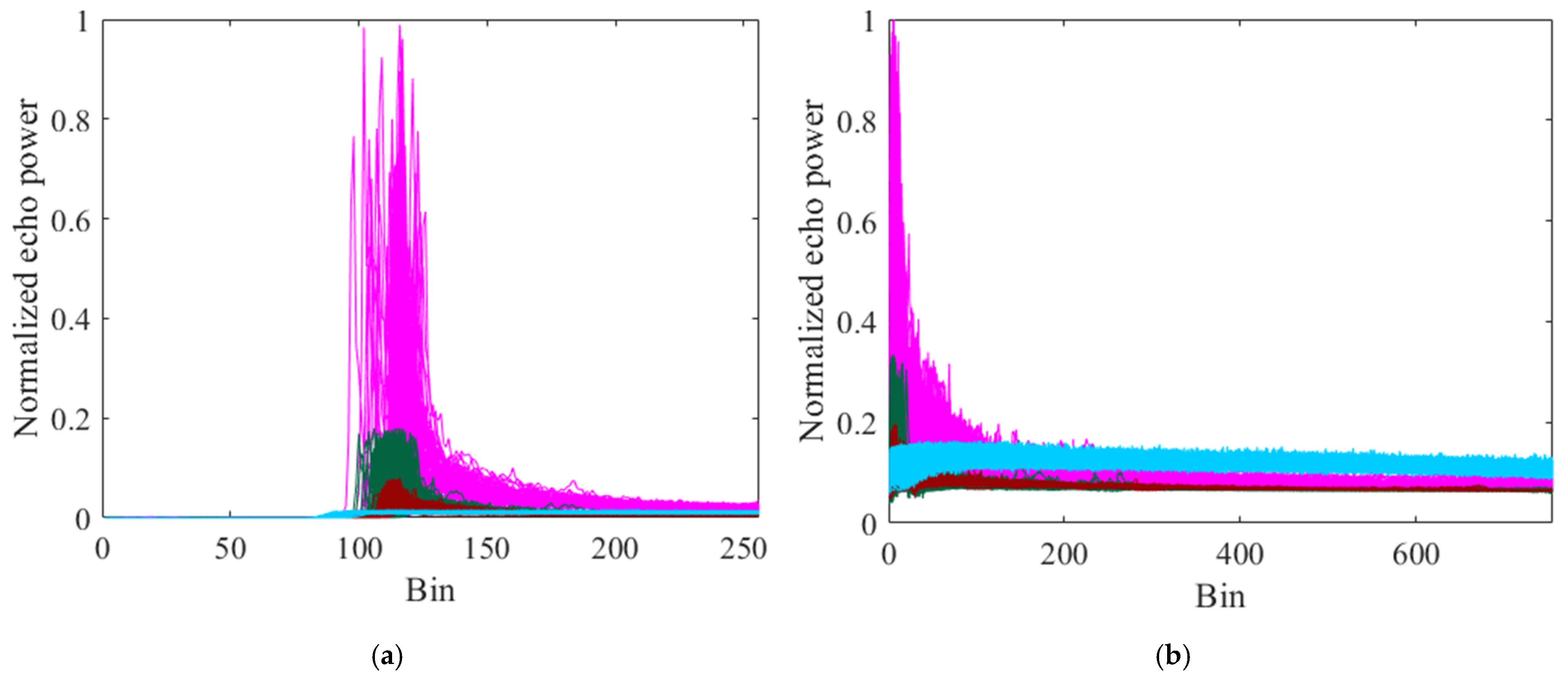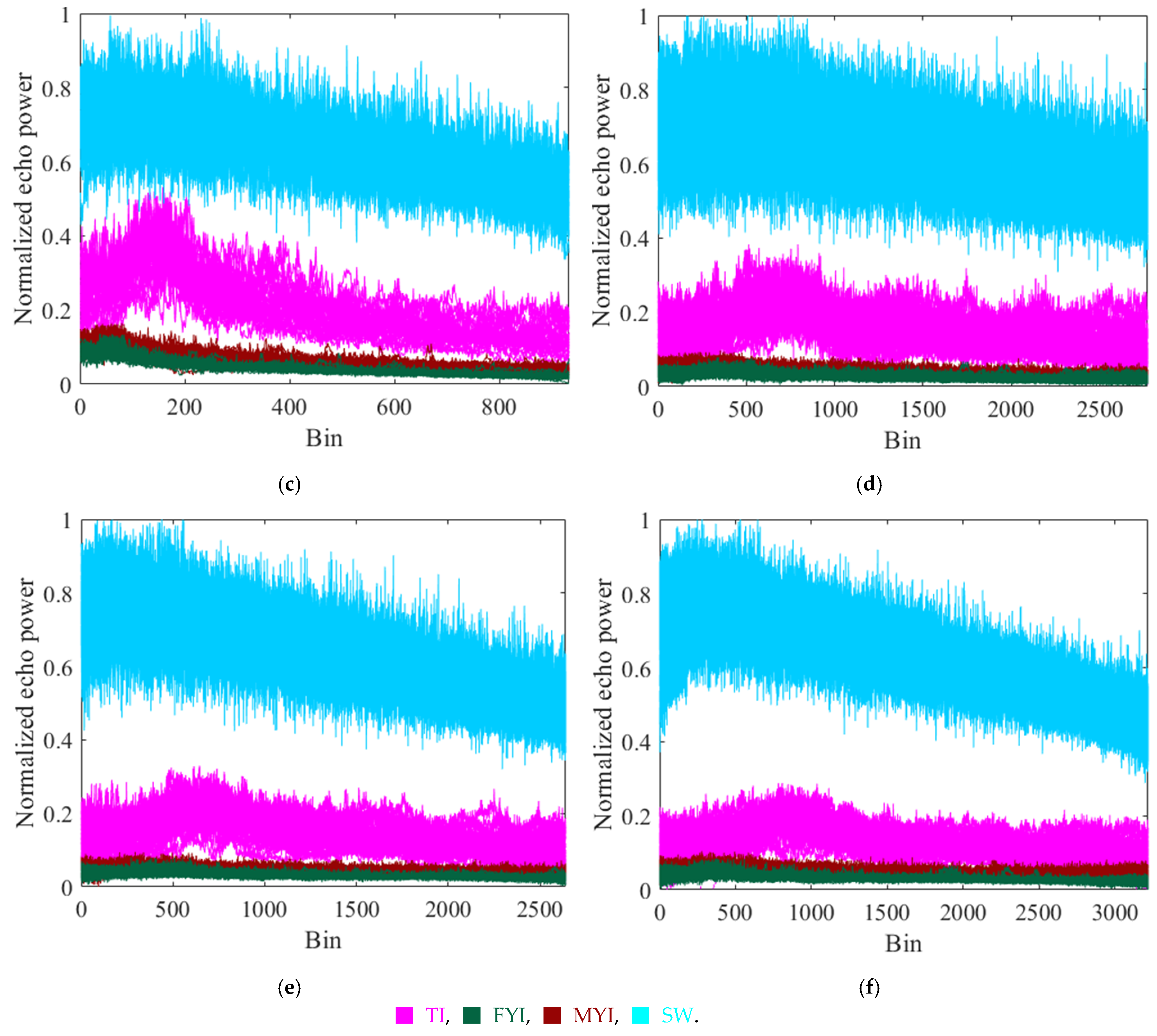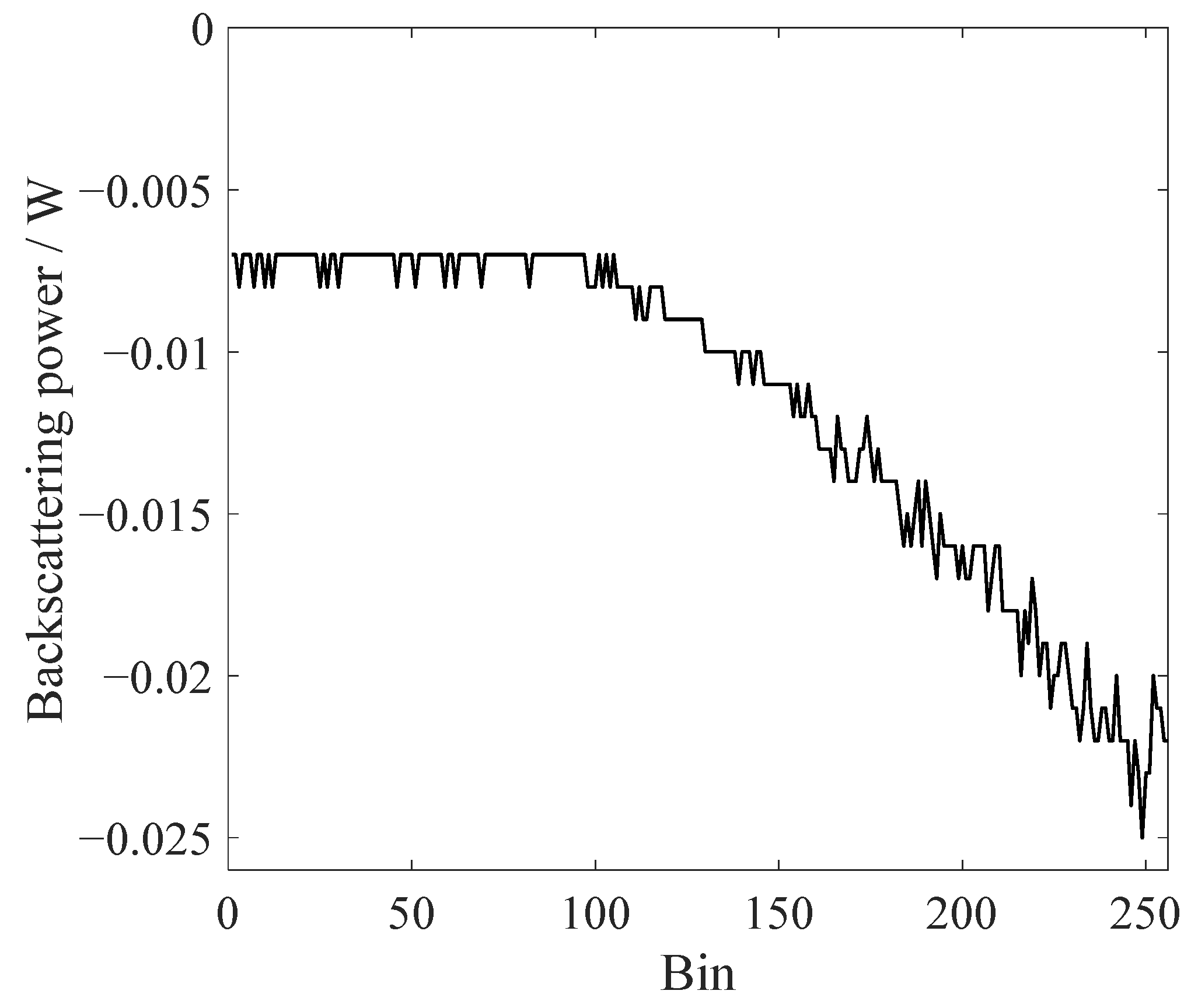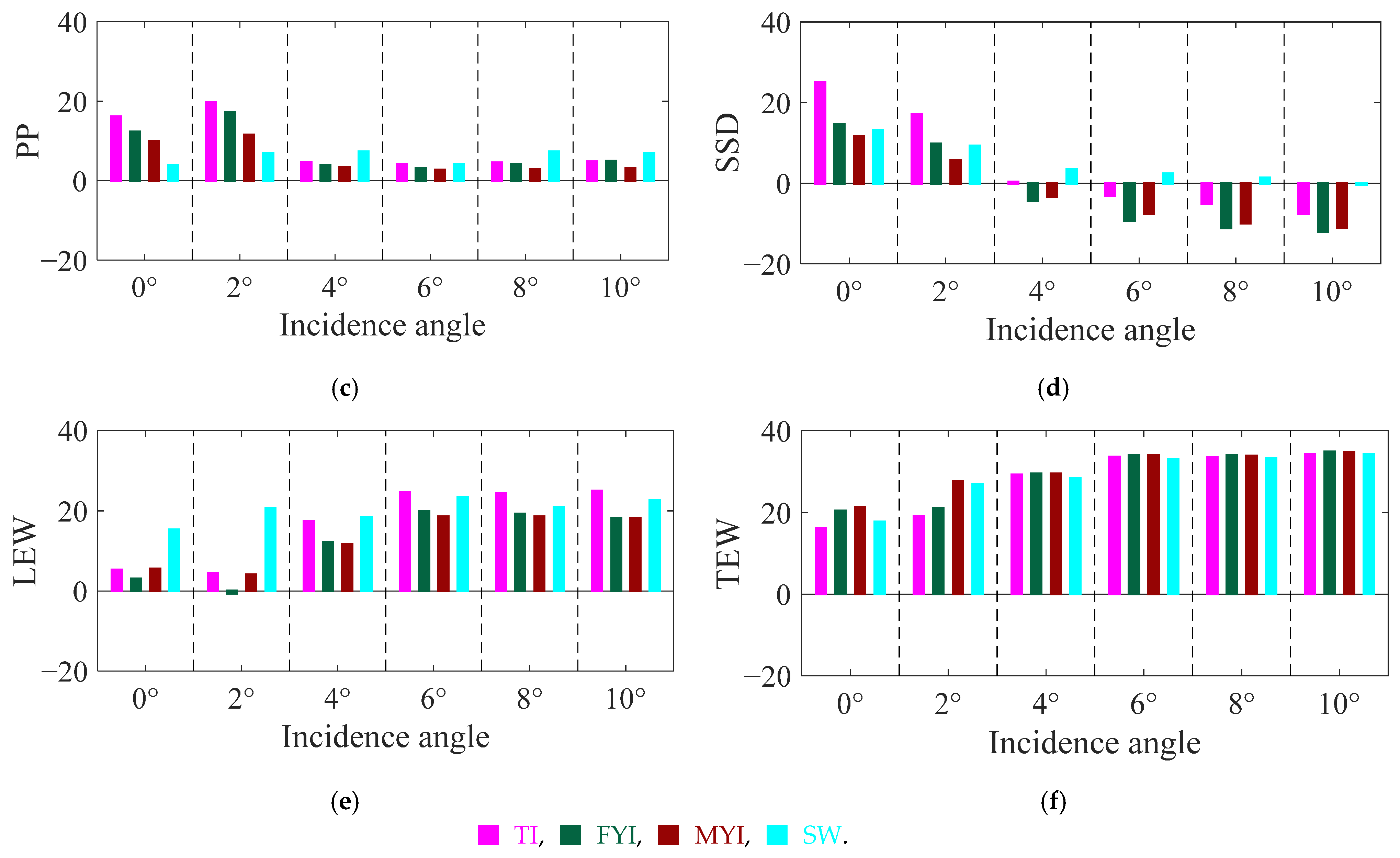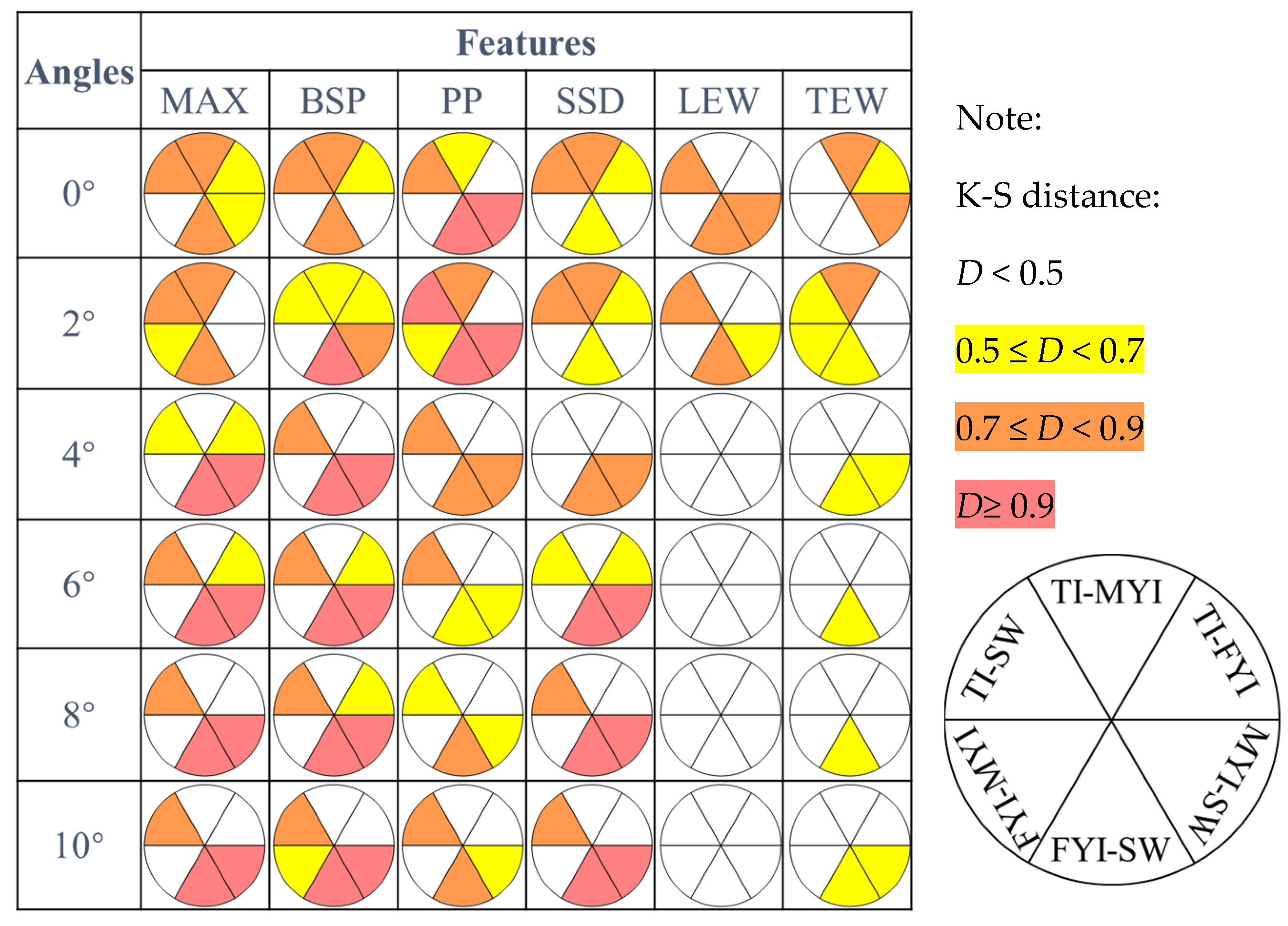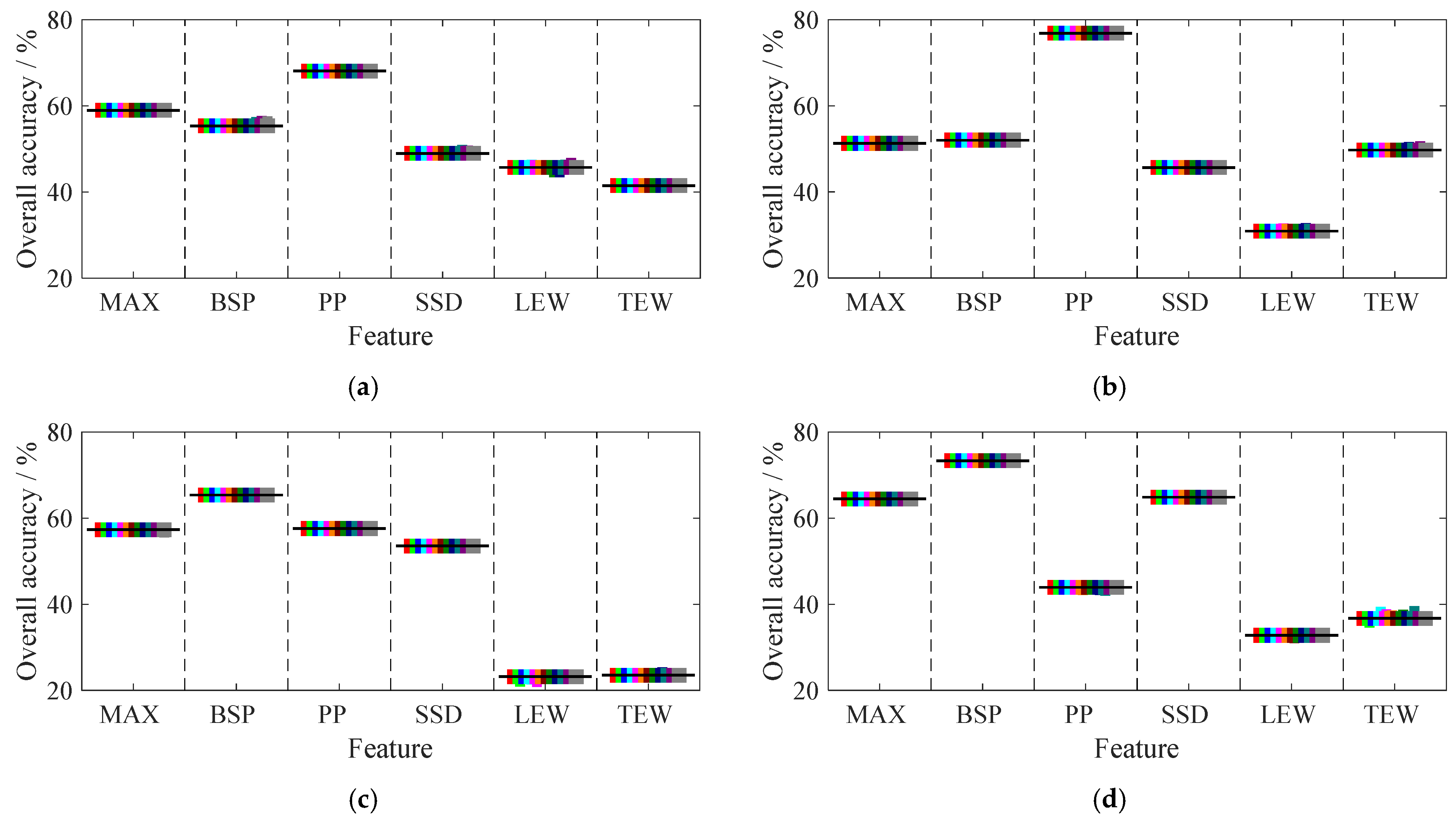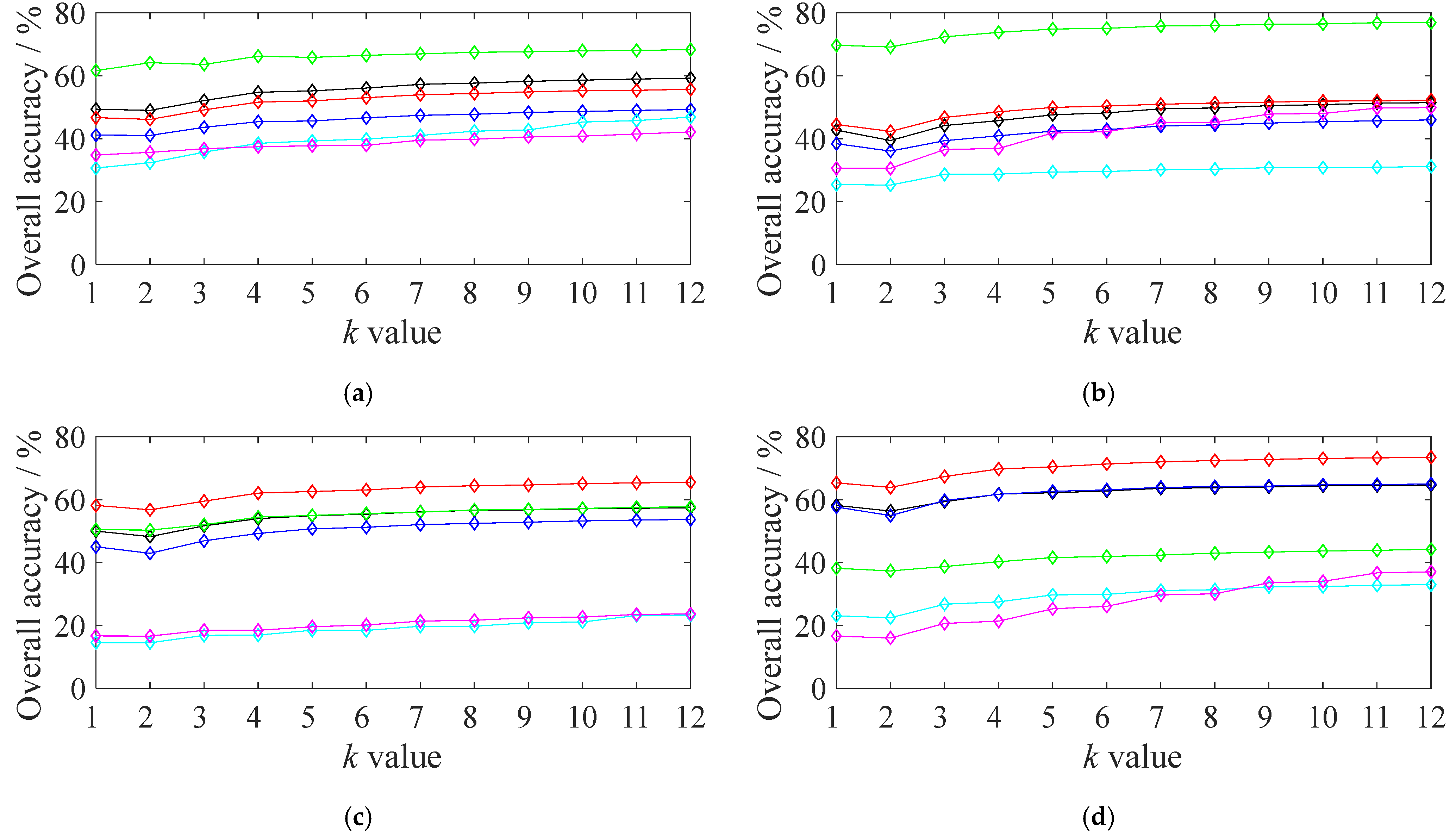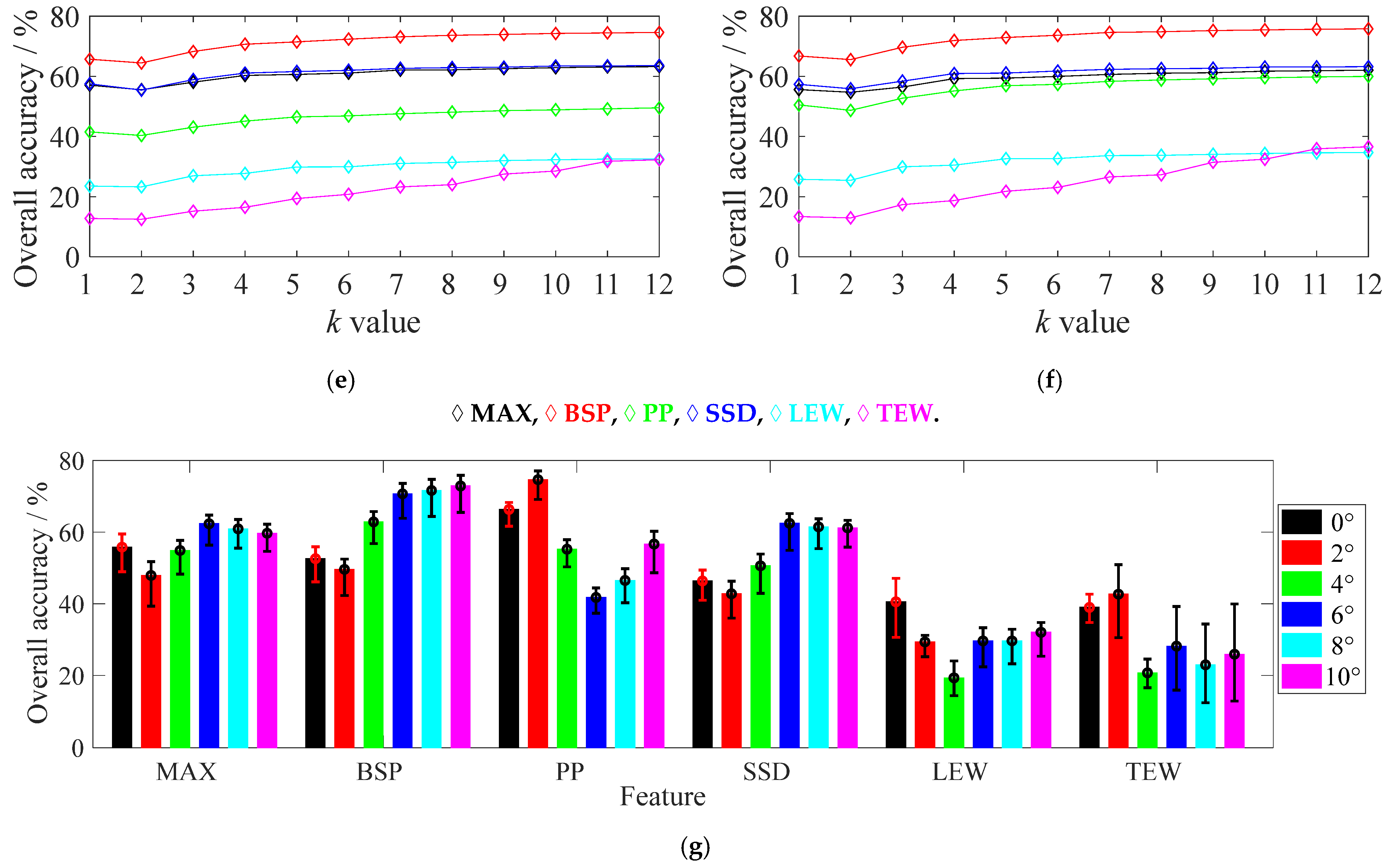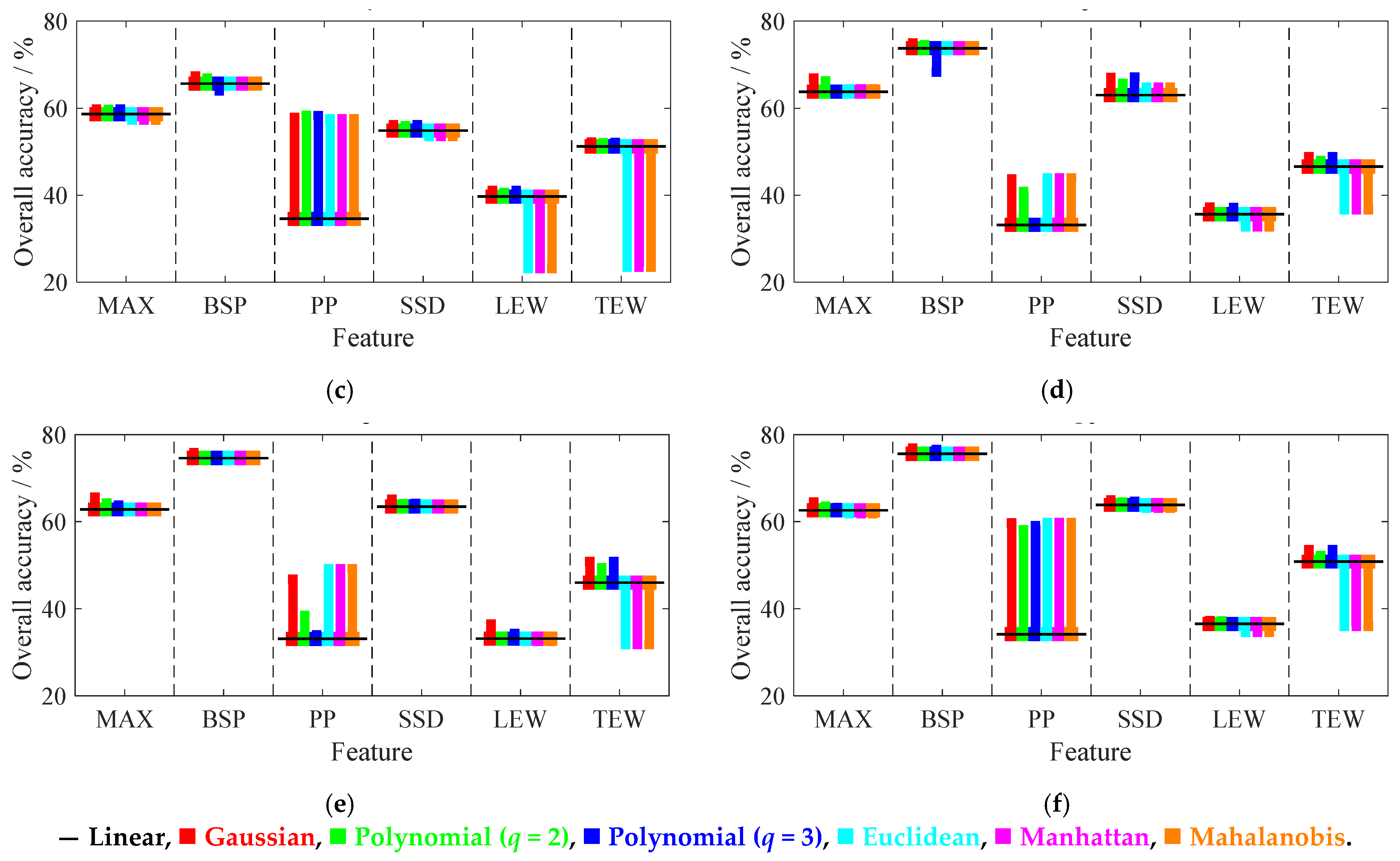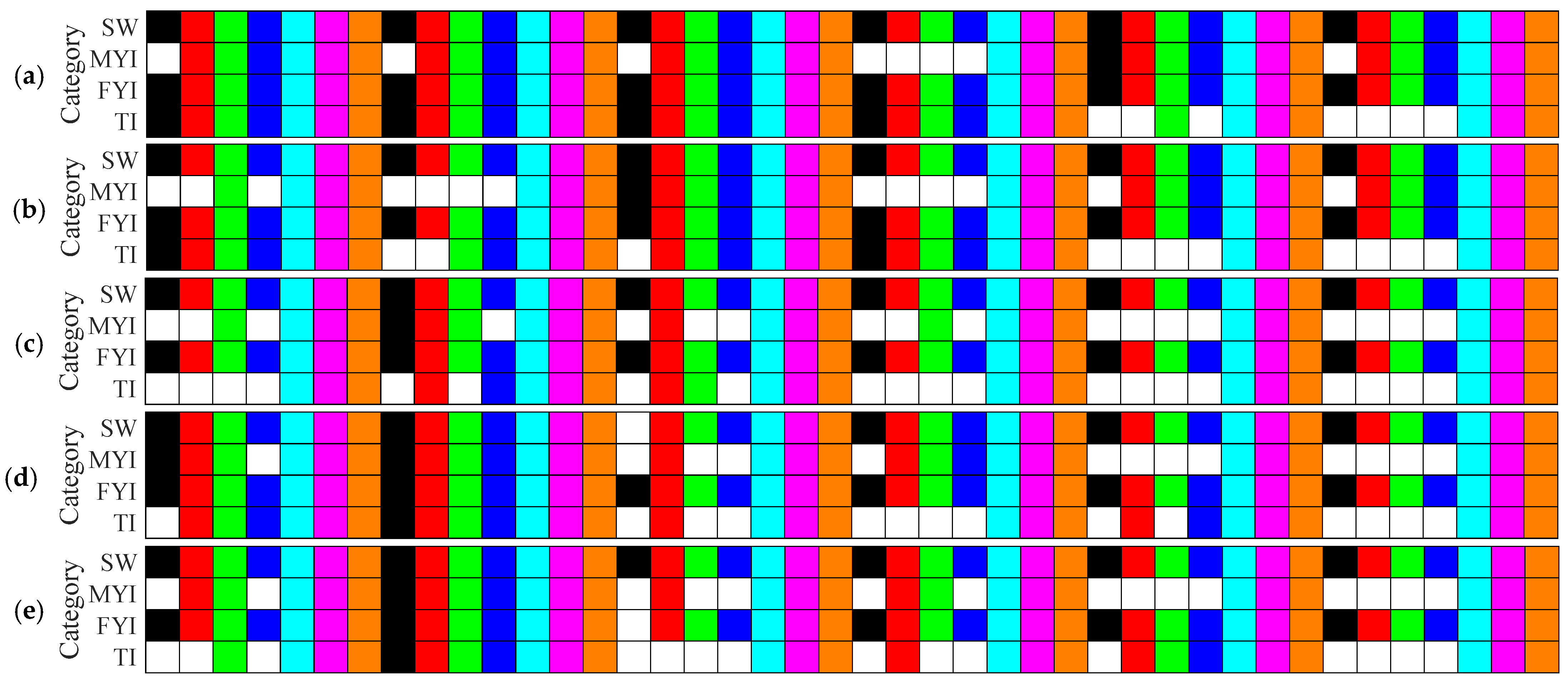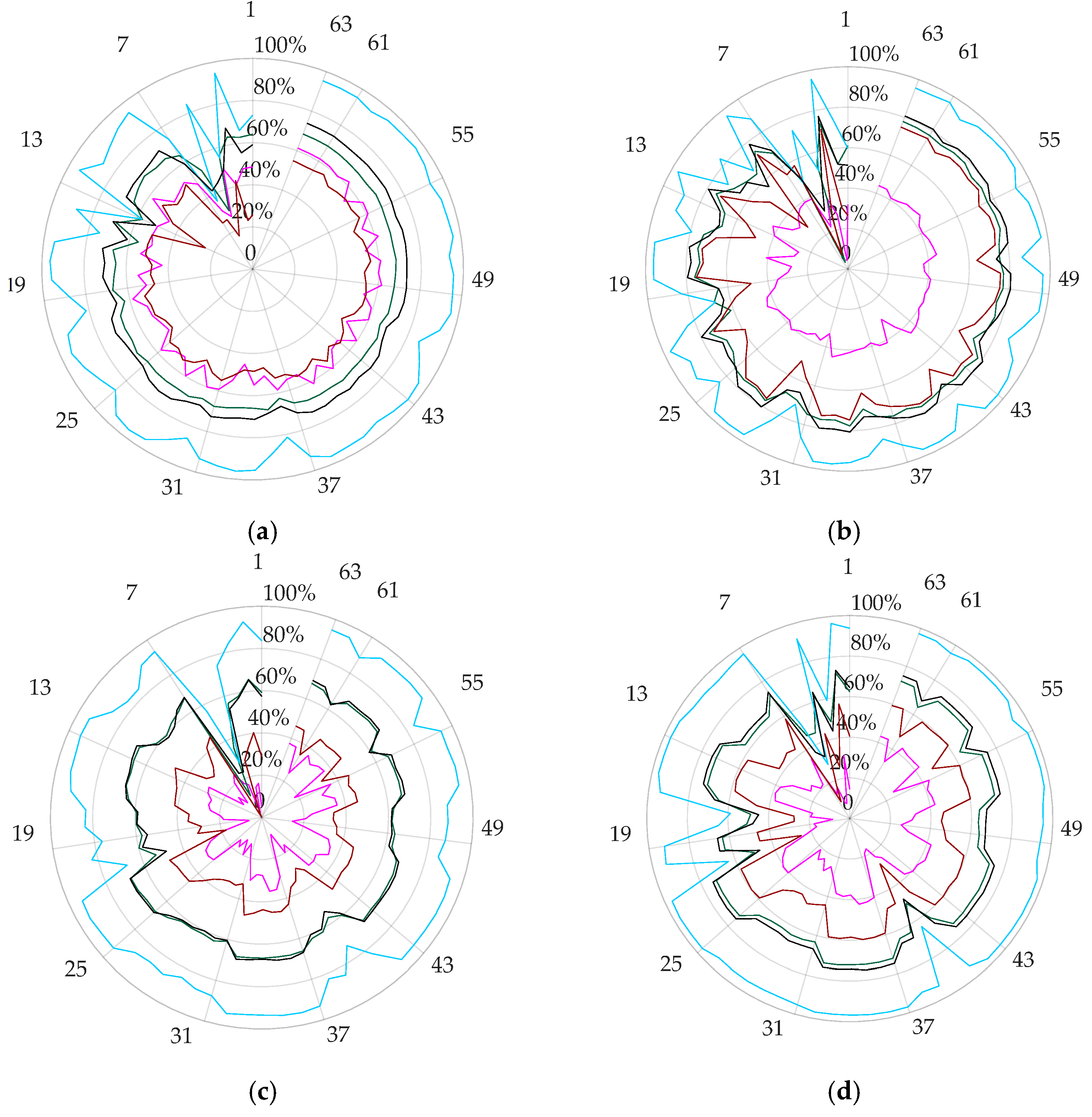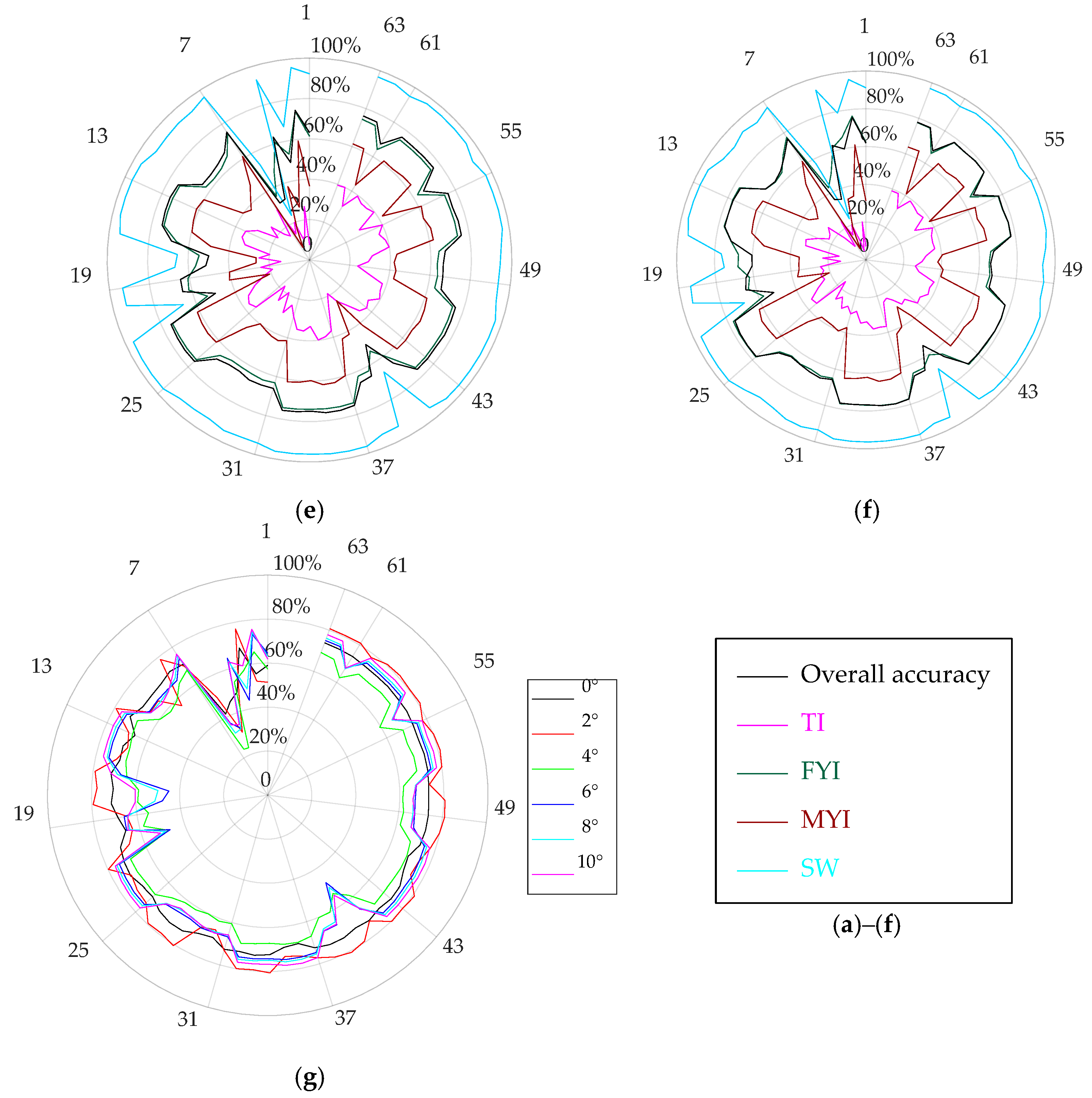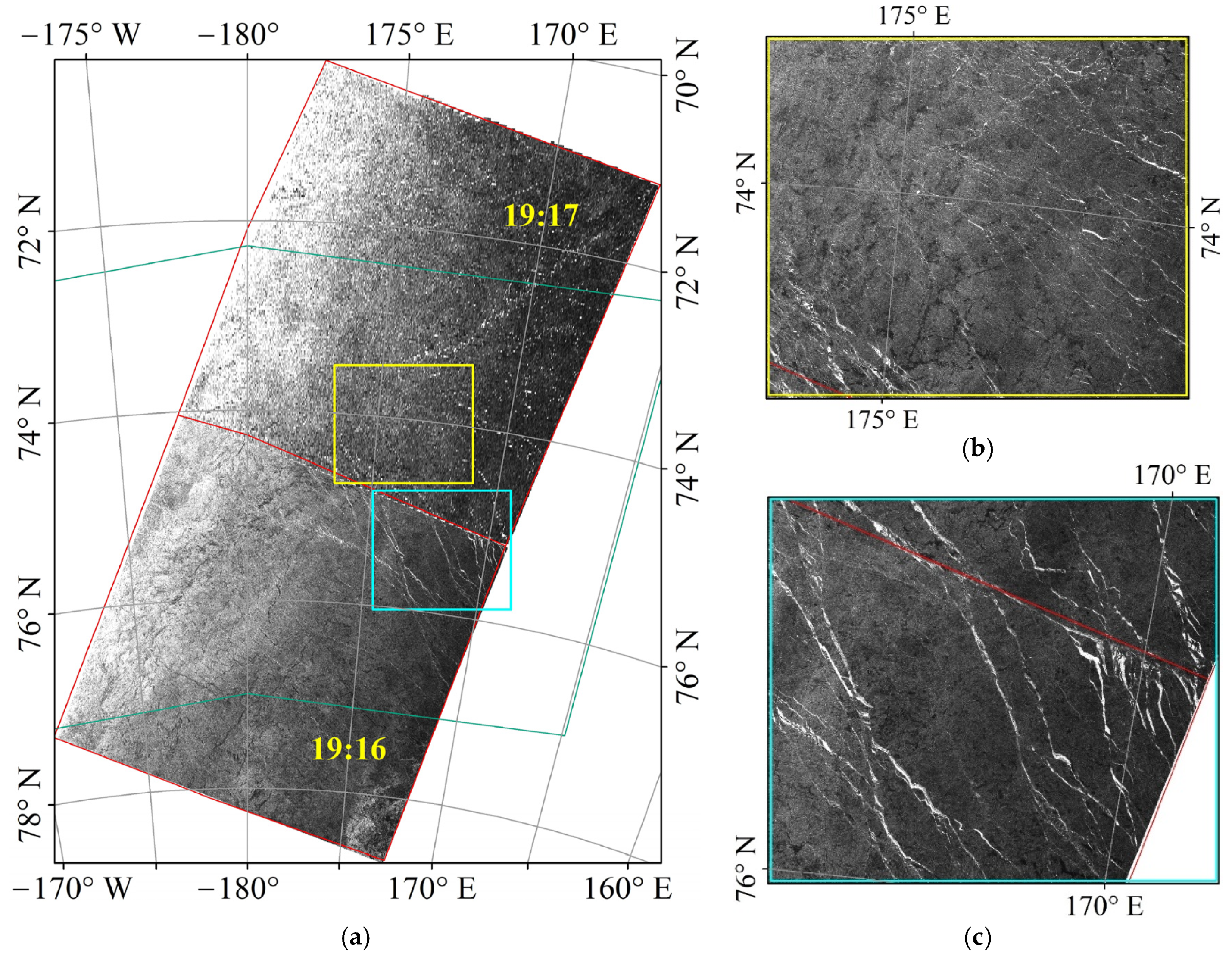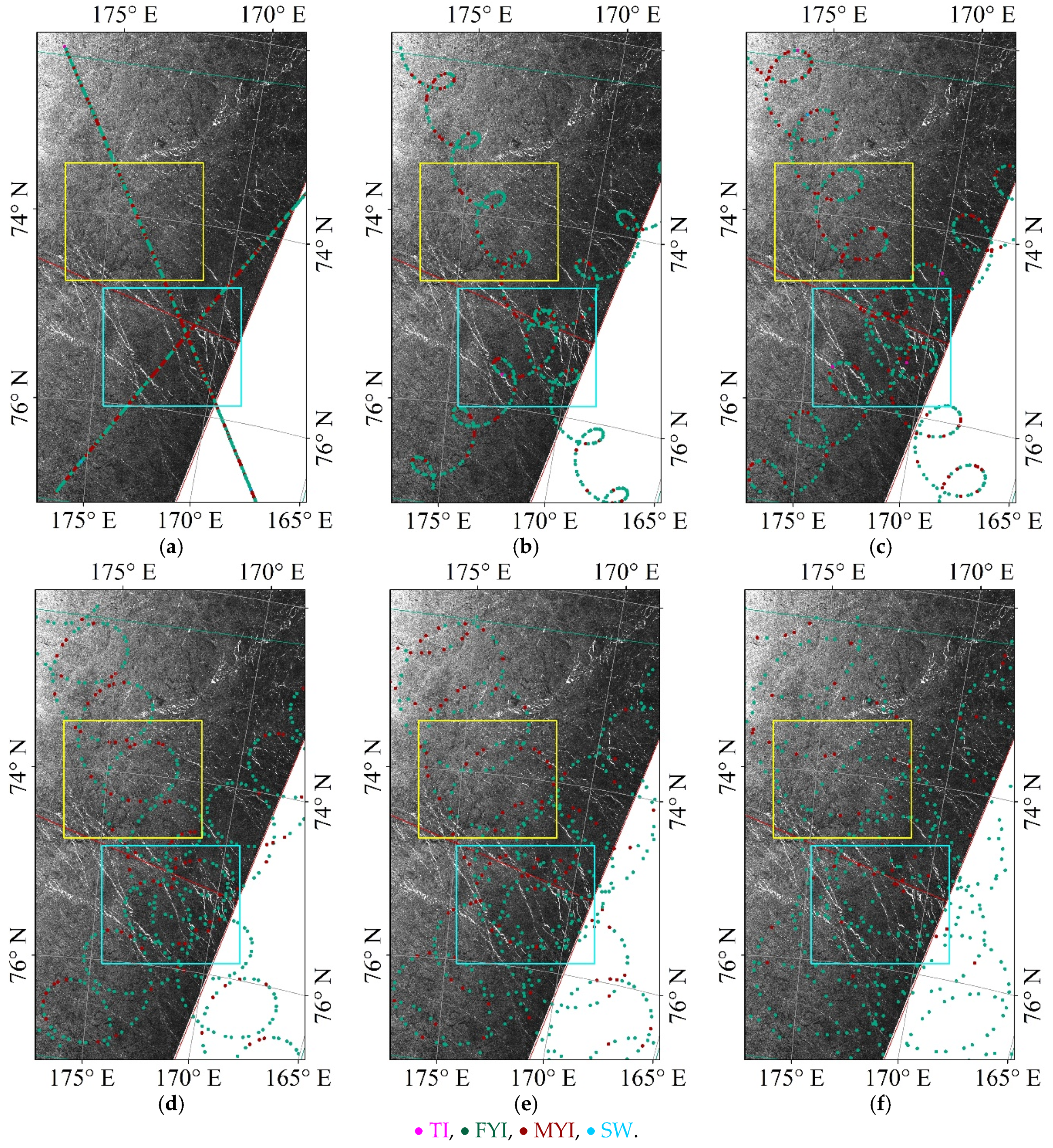1. Introduction
Sea ice influences a number of important processes, such as the global radiation balance and the exchange of heat and momentum between the ocean and the atmosphere, and sea ice has a strong influence on regional climate, marine and coastal habitats in Arctic environments, as well as marine transport and other human activities in and near polar seas [
1]. Sea ice extent clearly continues to exhibit a long-term downward trend over past years in the Arctic [
2]. Therefore, long-term sea ice monitoring is an important operational task. Sea ice type is one of the key parameters to characterize the properties and variations of sea ice, and a wide variety of tools are commonly used, including observations from ships, buoys, aircraft, and satellites [
3,
4]. Space-borne microwave sensors have been used in various studies to classify sea ice types, such as first-year ice (FYI) or multiyear ice (MYI), surviving more than one melting summer season, and sea water (SW) [
5,
6,
7].
Satellite-based microwave sensors mainly include synthetic aperture radar (SAR), altimeters and scatterometers. SAR is one type of imaging radar with medium incidence angles of 20° to 60° and high spatial resolution up to the submeter level. SAR monitors the local and regional sea ice distribution and variation for the recognition of sea ice types, sea ice condition assessment in important areas and fine navigation in the Arctic based on the abundant microwave backscattering information of sea ice. Sea ice classification has been performed for operational applications [
8]. Moreover, sea ice types and sea water can be distinguished automatically with high accuracies of up to 95% [
9,
10,
11].
An altimeter is mainly used for sea ice thickness retrieval using sea ice freeboard with a normal incidence mode based on large-scale and coarse spatial resolution (several to tens of kilometers) observations covering all polar regions. The ability to distinguish sea ice types can improve the conversion from freeboard to thickness. Waveform features are used in the recognition of sea ice types and sea water, such as backscattering power (BSP), maximum power (MAX), pulse peakiness (PP), leading edge width (LEW), trailing edge width (TEW), and stack standard deviation (SSD). Drinkwater and Carsey [
12] distinguished sea ice with rough surfaces and smooth surfaces using waveform features derived from airborne Ku-band radar altimeters. For smooth sea ice, the waveform peak is higher, and the trailing edge descends more quickly. Zygmuntowska et al. [
13] presented a Bayesian-based method to classify FYI and MYI using PP and TEW waveform features, and showed a classification accuracy of approximately 80%. Rinne and Similä [
14] presented an automatic classification system for detecting sea water, thin FYI, thick FYI, and MYI using a K-nearest-neighbors (KNN) classifier based on recent ice charts for training and four CryoSat-2 PP, LEW, SSD, and late-tail-to-peak-power ratio (LTPP) waveform features; the accuracies were approximately 85%. Shen et al. [
15] distinguished FYI from MYI using a random forest (RF) classifier based on six waveform features (TEW, LEW, σ
0, MAX, PP and SSD), and the accuracy was 85%. Shen et al. [
16] presented a systematic comparison of popular machine-learning classifiers with different feature combinations to find the optimal classifier–feature assembly, which was the RF accompanied by a feature combination of TEW, LEW, σ
0, MAX, and PP; the result achieved a mean accuracy of 91%. Shu et al. [
17] proposed an object-based random forest (ORF) classification method with a feature combination of σ
0, MAX, PP and SSD, and the overall classification accuracy was up to 90%. Sea ice classification using altimeters is still being researched and is not used operationally.
Scatterometers at medium incidence angles (20° to 60°) can observe sea ice all over polar regions to recognize sea ice types and sea water with a similar resolution to altimeters, including two major frequencies: the C-band (e.g., ASCAT, ERS-1/2) and Ku-band (e.g., QuickSCAT, OSCAT). Sea ice classification methods using scatterometer data can be divided into two categories. One is based on the microwave backscattering characteristics of sea ice, including the backscattering powers of the horizontal and vertical polarization. Sea ice and sea water recognition was first carried out using C-band data [
12,
18,
19], and then the Ku-band was demonstrated to be applicable for recognizing sea ice and sea water [
20,
21]. Recognition accuracies achieved 90% [
22]. As a result, operational products of sea ice extent and concentration in the Arctic and Antarctic have been manufactured for a long time [
23,
24,
25,
26]. The distinction of sea ice types (e.g., FYI and MYI) followed [
27,
28]. The other classification method is scatterometer image reconstruction (SIR) method. The reconstruction image can acquire a higher spatial resolution based on the multi-incidence and multi-azimuth original data of C- and Ku-band scatterometers and is used to distinguish sea ice types and sea water using image recognition methods [
4,
29,
30]. This operational method has been used to produce sea ice charts for nearly a decade, as proposed by Remund and Long [
24].
Microwave remote sensors with small incidence angles have been used for observation. The dual-frequency precipitation radar (DPR) onboard the Global Precipitation Measurement (GPM) adopts small incidence angles of ±17° using Ku-bands and Ka-bands. The GPM orbit is circular and non-sun-synchronous with an inclination of 65 degrees. As a result, the observation region of DPR only covers latitudes between 66.3° N and 66.3° S, and the DPR cannot detect the main areas in the Arctic. The Chinese-French Oceanic Satellite (CFOSAT) was successfully launched on 29 October 2018 and was developed by the China National Space Administration (CNSA) and the Centre National D’Etudes Spatiales (CNES) [
31,
32]. CFOSAT, which is devoted to observing ocean surface wind and waves, carries two Ku-band radar payloads: the wave scatterometer (Surface Waves Investigation and Monitoring, SWIM) and the wind scatterometer (rotating fan-beam scatterometer, RFSACT) [
33,
34]. SWIM is the first space-borne instrument using a rotating six-beam radar comprised of a scanning-beam real aperture radar operating at 13.575 GHz at small incidence angles (0° to 10°) [
35]. The main mission of SWIM is to obtain sea surface waves. RFSACT operating at 13.3 GHz, detects sea surface wind and sea ice properties with medium incidence angles (26° to 61°) [
36]. Sea ice detection in the small incidence angle mode has rarely been studied thus far. Therefore, for a new detection mode of small incidence angles, several key problems should be studied in sea ice classification, such as the ability to recognize sea ice types and sea water, the performance of each small incidence angle in category discrimination, the selection and optimization of waveform features or waveform feature combinations and classifiers, the application of optimal multifeature combinations using selected classifiers, and the abilities of small, normal and medium-incidence sensors in sea ice classification. Therefore, our work focuses on the study of sea ice classification using the SWIM data at small incidence angles according to these problems, which can promote new sea ice detection technology and expand new horizons for SWIM ocean detection applications.
Section 2 describes the data sets of SWIM data, Sentinel-1 SAR images and sea ice charts in the Arctic from October 2019 to April 2020, and data processes including waveform feature extraction, data matching and filtering. Moreover, the analysis method of sea ice discrimination ability and sea ice classification methods are also introduced.
Section 3 presents results of waveform analysis, sea ice discrimination ability, overall accuracies of different methods, and sea ice classification results using multi-feature combinations of SWIM data.
Section 4 discusses the comparison with previous achievements, the recognition rate of sea water, the influence of snow coverage, the feasibility of new feature introduction, and the necessity of further similar studies.
Section 5 presents the conclusions and an overview of future work.
4. Discussion
In this study, the sets of three incidence angles reveal their own characteristics in sea ice types and sea water recognition using single features of SWIM data. At 0–2°, PP, as a widely used feature, has higher accuracy in sea ice and sea water discrimination [
14,
46,
51,
52]; MAX is also a useful parameter in sea ice classification [
13], and BSP, as a most popular parameter, can play an important role at six incidence angles [
15,
17,
50]. At 6–10°, BSP is the best feature coincident with scatterometers and SARs [
28,
53], and MAX and SSD behave better and are also useful at 0–2° [
15,
16,
17,
52]. At 4°, BSP, PP and MAX have better features in agreement with 0–2°; BSP has the highest accuracy consistent with 6–10° and it is indicated that 4° has properties of both 0–2° and 6–10°. In prior studies in multifeature combinations at 0°, the optimal combinations were BSP, MAX, PP and SSD [
17], BSP, MAX, PP, LEW and TEW [
16], MAX, PP, LEW, TEW and TES (trailing edge slope is MAX divided by TEW) [
13], PP, SSD, LEW and LTPP (late tail to peak power ratio) [
14], which is similar to our results (MAX, BSP, PP, SSD, LEW and TEW).
Zygmuntowska et al. [
13] showed a classification performance of 78.7% (FYI, PP and TEW) and 81.7% (MYI, MAX and TEW) using the Bayesian method based on echo waveforms of the CryoSat-2 radar altimeter. Rinne and Similä [
14] obtained classification accuracies of FYI (<70 cm) at 15–26%, FYI (>70 cm) at 75–92% and MYI at 77–92% in the Kara Sea in March 2014 using KNN based on Cryosat-2 data. Shen et al. [
15] applied a random forest (RF) machine learning approach to obtain classification performances of 82.58% for FYI and 72.53% for MYI. Shu et al. [
17] achieved an overall classification performance of 92.7 ± 3.3% (FYI) and 83.8 ± 3.59% (MYI) using the object-based RF (ORF) method based on Cryosat-2 data. These studies were validated by AARI sea ice charts. Aldenhoff et al. [
52] introduced IMP (scaled inverse mean power) to improve the distinguishing FYI and MYI, which could enhance contrast when waveforms have similar peak values. The classification accuracies of thin ice and MYI are lower than those of other categories, and sea water has a higher classification performance, which agrees with our results. The classification accuracies of FYI and MYI are lower than those of Shen et al. [
15] and Shu et al. [
17], and new methods should be used for sea ice classification of SWIM data in future work.
Snow has an important influence on sea ice classification results, especially on MYI recognition. The Ku band can penetrate the snow layer to the snow-ice interface in theory, but wet snow makes the signal power dissipate and changes the characteristics of echo waveforms significantly, such as TEW [
54]. MYI loads thicker snow than FYI. Thus, snow cover plays a more important role in MYI recognition of the Ku band [
55]. It is necessary to study the effect of snow coverage on the microwave signal of sea ice types. Touzi [
56] proposed a new scattering vector model for the expression of coherent target scattering based on polarimetric C-band SAR data, which could make coherent and partially coherent target scattering unified and decomposed. The symmetric scattering type phase in this model particularly exhibited a hopeful prospect for wetland classification, which would be useful for the study of snow coverage. Muhuri et al. [
57] developed a mapping method of snow coverage using the Touzi eigenvalue-eigenvector-based decomposition parameters based on RADARSAT-2 C-band polarimetric SAR data. The results were comparable to those from spaceborne optical images, and agreed well with real-time field measurements. This research will represent the reference for the influence analysis of snow coverage on sea ice classification at small incidence angles. Moreover, this research will also be used for the ability comparison of the small, normal and medium-incidence sensors in sea ice classification.
Other wave features can be analyzed in sea ice classification, such as IMP and TES. Inverse mean power (IMP) [
52] is calculated as follows:
IMP represents the total power contained in one waveform. This parameter is scaled by 2 × 10
−13 to avoid too small values, and hence increases readability. The trailing edge slope (TES) is MAX divided by TEW and expresses the falling rate of the trailing edge of the waveform.
The overall accuracies and F1 scores of IMP and TES at small incidence angles are shown in
Table 10. TES behaves better than TEW and LEW, especially for 4°–10°, because TES combines the characteristics of MAX and TEW. IMP does not behave better than the above six features in overall accuracies, but performs well in the discrimination of FYI and MYI in the F1 scores.
In addition, because sea ice may ‘pollute’ SWIM wave products, SWIM data should include sea ice concentration information, which is the recognition of sea ice and sea water. In this study, sea water obtains a higher classification accuracy expressed by the F1 score compared with sea ice. At six incidence angles, the accuracies of every category are expressed by the F1 score, as shown in
Table 11. The highest F1 scores of sea water at 0–2° and 6–10° are approximately 97%, and are slightly less than 95% at 4°. The highest overall accuracy is up to 97% at 6°, and the lowest is near 95% at 4°. For 0–2° and 6–10°, four out of the six top combinations are the same (No. 27, 43, 52, 57; and No. 55, 60, 62 63, respectively). In addition, 4° has the same multifeature combinations at both 0–2° and 6–10°, in agreement with the previous analysis in
Section 3.1. Jiang et al. [
46] distinguished sea ice and sea water using KNN and SVM based on wave features such as the PP of Haiyang-2 A/B, and their accuracies were approximately 80%. Müller et al. [
58] monitored the Arctic seas using KNN and K-medoids based on wave features such as MAX of ENVISAT and SARAL with accuracies up to 94%. Thus, SWIM has strong abilities for sea ice and sea water recognition at multiple small incidence angles.
5. Conclusions
SWIM, as an innovative remote sensor and has the potential for sea ice classification. For the new detection mode using multiple small incidence angles of SWIM, our research focuses on the ability to discriminate sea ice types and sea water, classifier selection and setting, analysis of multifeature combinations, and application of the optimal multi-feature combination with the selected method.
The SWIM data should be pretreated first. The waveforms of SWIM in the Arctic from October 2019 to April 2020 are given category labels of TI, FYI, MYI and SW using sea ice AARI charts. Then, waveform features are extracted, including the MAX, BSP, PP, SSD, LEW and TEW. The K-S distance is used to assess the ability to discriminate sea ice types and sea water. Moreover, KNN and SVM methods are introduced as sea ice classification methods.
According to the waveform analysis combining the waveform features, the six incidence angles can be divided into three sets. At 0–2°, the waveform has a notable peak; at 6–10°, the waveform is flat; and 4° seems to be a transition between 0–2° and 6–10°. LEW and TEW have difficulty correctly discriminating because of fluctuations. The discrimination ability of single features using the K-S distance shows that the waveform features at all incidence angles distinguish between sea ice and sea water better than among sea ice types. MYI and TI are difficult to discriminate. LEW behaves the worst in distinguishing the categories at 4–10°. It is concluded that the three incidence sets have different discrimination abilities. These results agree with the waveform analysis. The overall accuracies of six waveform features for the SVM method using the Gaussian kernel at 0–10° are the highest, those for the linear kernel are the lowest, polynomial kernel 3 performs slightly better than polynomial kernel 2, and the three distances of the KNN method behave similarly. However, the SVM clearly misses the detection of sea ice types, especially MYI and TI. Therefore, the KNN method (the Euclidean distance and k equal to 11) is chosen to distinguish sea ice types and sea water. Sea ice classification results based on multifeature combinations at small incidence angles with the KNN method show that the highest overall accuracy is up to 81% at 2°, and the lowest is approximately 70% at 4°. The three incidence sets have differences, and 4° behaves similarly to 6–8°. The features of the PP and BSP have better discrimination abilities both in the analysis of the waveform and K-S distance and in multi-feature combinations. However, the SSD is not a better feature in the former analysis but plays a significant role in multifeature combinations. Moreover, LEW and TEW have difficulty recognizing sea ice types but are useful in multifeature combinations. The analysis of a single feature is different from the multifeature combination. Moreover, the top multifeature combinations with the KNN method are applied for randomly selected data in one day that are not filtered. The results suggested that optimal multifeature combinations with the KNN method are practical. Furthermore, the top multi-feature combinations with the KNN method are also applied for sea ice classification in the local regions, and the results are analyzed and compared with Sentinel-1 SAR images. The SWIM data are only filtered simply, so the classification results are representative and universally significant. It is concluded that optimal multifeature combinations with the KNN method are effective in sea ice classification.
Our results are compared with those of other studies and have better consistency. Moreover, sea water has very high classification accuracies of more than 96% at 0–2° and 6–10°, which meets the SWIM demand of sea ice discrimination. The influence of snow coverage is also discussed. Furthermore, the introduction of new waveform features can contribute to improving the classification accuracies, such as TES and IMP. Therefore, our results confirm the potential of sea ice recognition using the new data of SWIM. A sea ice classification method at small incidence angles is proposed, which can fill the gap in the research on sea ice monitoring of microwave remote sensing at small incident angles. Moreover, our work can also greatly promote new sea ice detection technology and application in the Arctic and Antarctic with significant theoretical and practical values.
In future work, more SWIM data of new ice years in the Arctic should be used to promote research on sea ice classification. The recognition abilities of new features and feature combinations, such as TES and IMP, will be evaluated further. Moreover, other classification methods, such as deep learning and SIR, will be assessed for their classification abilities, and the effect of snow coverage will also be considered. The abilities of the small, normal and medium-incidence sensors in sea ice classification will be investigated in depth.

